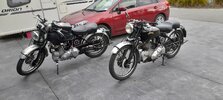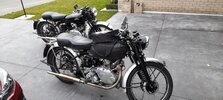The standard steering damper is a friction damper which should be called a stiction damper, once moving the friction DECREASES, the opposite of what is required, this is why they were dropped from suspension as soon as hydraulic dampers came along.
You are using an out of date browser. It may not display this or other websites correctly.
You should upgrade or use an alternative browser.
You should upgrade or use an alternative browser.
FF: Forks M
- Thread starter Bazlerker
- Start date
And the stiffer it is to start with, The more you have to overcome it ,
And so it begins, Too much, Too much, = S--- !.
And so it begins, Too much, Too much, = S--- !.
Further to above, today I cut 6mm off the temporary Benelli springs I had fitted, from 400mm to 394mm. This dropped the back of the bottom link to the recommended height. I also adjusted the AVO damper to the softest setting. The steering felt marginally lighter walking around, but the suspension felt a lot softer and better controlled when riding. Then I had an opportunity to ride another Comet, we took both bikes for a trot up the valley past my house for about 6 miles of winding, undulating rural road, swapped and rode home. Interesting back to back comparison between the Comet with modified steering and one with standard steering and friction damper.Just for the record, I have recently fitted one of Norman's JE steering stem/yoke assemblies, without an hydraulic damper, to a Comet. The change in steering sensation took me by surprise. When walking the bike around, the bars wanted to "flop" towards full lock. When riding, the steering felt heavy up to about 25MPH, then it felt more normal, but required positive counter steering input.
I put this down to the increase in trail.
Prior to fitting the new yoke, I drew it, then drew the original for reference. According to my measurements, the bottom link pivot has moved back about .539" and down .723" (If anyone else has worked through this and has different figures, please feel free to correct me, my maths and drawing can both be a bit average)
Keeping the calcs simple, moving the pivot back 1/2" means the axle moves back about 1 3/8", a theoretical increase in trail of about that amount. It should come as no surprise to feel a distinct change in feel of the bars. An increase of 1 3/8 trail should also ensure total stability, but as there are always other factors which can contribute to weave and tank slappers, no guarantee of tank slapper free steering.
The sensation had enough effect on me that I called Greg Brillus, who has fitted many of these units and asked if I may have done something wrong with fitting. His response was; he always fits an hydraulic steering damper with the stem and has not experienced what I described. We agreed that the internal friction of a steering damper probably masks the sensation.
We agreed that the suspension of the modified-steering-bike is definitely nicer, the "standard" one has single Comet springs and standard bushes which make it feel firmer.
The steering of the modified bike is noticeably more "sluggish", requires more counter steering input but is totally stable. Stepping off the modified bike onto the "standard" bike caused me to "oversteer" initially, I pushed the bars harder than needed and the bike turned in noticeably quicker. It took a few corners to readjust, but it never felt unstable.
Attachments
Did you buy a comet?Further to above, today I cut 6mm off the temporary Benelli springs I had fitted, from 400mm to 394mm. This dropped the back of the bottom link to the recommended height. I also adjusted the AVO damper to the softest setting. The steering felt marginally lighter walking around, but the suspension felt a lot softer and better controlled when riding. Then I had an opportunity to ride another Comet, we took both bikes for a trot up the valley past my house for about 6 miles of winding, undulating rural road, swapped and rode home. Interesting back to back comparison between the Comet with modified steering and one with standard steering and friction damper.
We agreed that the suspension of the modified-steering-bike is definitely nicer, the "standard" one has single Comet springs and standard bushes which make it feel firmer.
The steering of the modified bike is noticeably more "sluggish", requires more counter steering input but is totally stable. Stepping off the modified bike onto the "standard" bike caused me to "oversteer" initially, I pushed the bars harder than needed and the bike turned in noticeably quicker. It took a few corners to readjust, but it never felt unstable.
I find it interestinhg that the steering feels 'sluggish'. I thnk that most of the 500 cc Vins racing are using either the JE stem or the DaveD one, both of which do essentially the same job. Clearly those chaps find the handling acceptable so what is it that creates two different impressions and yet seems acceptable to several users. Certainly the nearly 300 road users seem to be fairly happy or they would have let me know by now. Anyone got any ideas?
A question here, did both bikes have the same tyre wear/pressure, if not then any of those could have made a difference, as an example my own twin used to have 90/90 19 Roadriders, last change I fitted a 3.25 19 Roadrider that looks identical and Avon list similar dimensions but it feels considerably more "sluggish", I also find the tyres susceptible to a small pressure drop.
I don't have the numbers in front of me, but in general, using a concentric shortens the trail from stock because it is moving the lower link halfway to the sidecar position. The sidecar position is closer to no trail because lots of trail makes steering very heavy for a sidecar machine. In the old days, many owners used a short top link for sidecar work because the eccentric was a compromise and did not shorten the trail as much as someone with a double adult sidecar would desire.
In the US, almost all of the Vincent racers are using the DD steering stem, but the slow steering is caused by the large rake and not the steering stem. All of the racers using the new stem have also steepened the rake. So, it may seem like the two are connected, but they are not.
The easiest way to alter the rake is to use the Reg Bolton mod described years ago in MPH. This mod also gives more ground clearance as an added benefit.
David
In the US, almost all of the Vincent racers are using the DD steering stem, but the slow steering is caused by the large rake and not the steering stem. All of the racers using the new stem have also steepened the rake. So, it may seem like the two are connected, but they are not.
The easiest way to alter the rake is to use the Reg Bolton mod described years ago in MPH. This mod also gives more ground clearance as an added benefit.
David
The 'sluggish' feel of the JE Stem equipped bike when compared with a standard bike could be due to the fact that whereas the standard forks provide 3.25 inches of trail at null (laden) deflection, Girdraulics with the JE Stem have 3.83 inches of trail when at null.
It is interesting to observe the respective changes in trail as the forks extend and compress. Whereas trail provided by the JE Stem varies from 4.42 inches at full extension to 3.54 inches at full compression, the trail provided by the standard Series C fork varies from 5.28 at full extension to 1.79 inches at full compression.
The increased leverage provided by the full extension trail of the standard fork (5.28 inches) and the decrease in the moment of inertia of the steered assembly which occurs when the fork extends (38% compared to the MoI at full compression) are the reasons why the Girdraulic fork is so prone to tank slappers. Essentially the self aligning force generated by tyre is given a longer lever to shift a smaller load!
It is interesting to observe the respective changes in trail as the forks extend and compress. Whereas trail provided by the JE Stem varies from 4.42 inches at full extension to 3.54 inches at full compression, the trail provided by the standard Series C fork varies from 5.28 at full extension to 1.79 inches at full compression.
The increased leverage provided by the full extension trail of the standard fork (5.28 inches) and the decrease in the moment of inertia of the steered assembly which occurs when the fork extends (38% compared to the MoI at full compression) are the reasons why the Girdraulic fork is so prone to tank slappers. Essentially the self aligning force generated by tyre is given a longer lever to shift a smaller load!
This has to be the most succinct explanation yet.The increased leverage provided by the full extension trail of the standard fork (5.28 inches) and the decrease in the moment of inertia of the steered assembly which occurs when the fork extends (38% compared to the MoI at full compression) are the reasons why the Girdraulic fork is so prone to tank slappers. Essentially the self aligning force generated by tyre is given a longer lever to shift a smaller load!
No, not so lucky Gene.Did you buy a comet?


